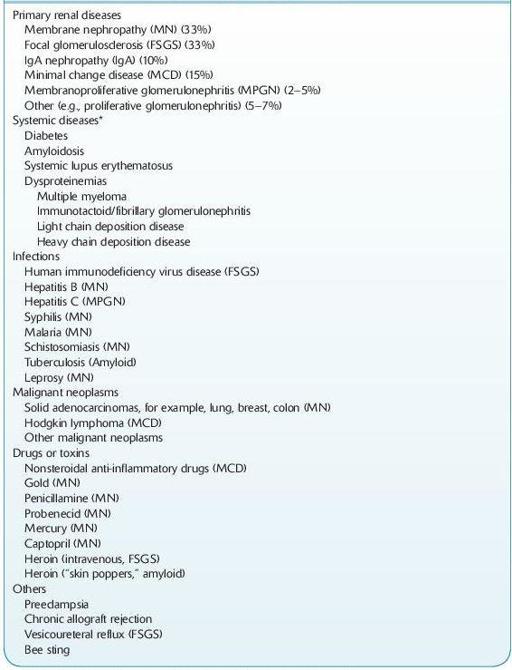Wallach's Interpretation of Diagnostic Tests: Pathways to Arriving at a Clinical Diagnosis (543 page)
Authors: Mary A. Williamson Mt(ascp) Phd,L. Michael Snyder Md

BOOK: Wallach's Interpretation of Diagnostic Tests: Pathways to Arriving at a Clinical Diagnosis
12.3Mb size Format: txt, pdf, ePub
Focal nephritic: generally associated with inflammatory regions in less than one half of glomeruli. Patients often present with asymptomatic hematuria and proteinuria.
Diffuse nephritic: heavy proteinuria, edema, and hypertension may be observed.
Causes
Renal: can be postinfectious (due to certain nephritogenic strains after streptococcal, staphylococcal, or pneumococcal infections, mumps, measles, chickenpox, hepatitis B and C) or due to MPGN or anti–glomerular membrane disease.
Systemic: due to SLE, vasculitides, IgA nephropathy, or Henoch-Schönlein purpura.
Laboratory Findings
Urinalysis: oliguria (<400 mL/day), proteinuria (usually <3.5 g/day), and hematuria, with RBC casts.
Uremia and azotemia.
Complement C3 level is usually decreased. Immunologic tests (e.g., anti-GBM antibodies, ASO) can help in the differential diagnosis.
Renal biopsy establishes the diagnosis.
NEPHROTIC SYNDROME
This syndrome presents as heavy proteinuria, hypoalbuminemia, hyperlipidemia, lipiduria, and edema.
Causes
Primary glomerular diseases are responsible for >50% of all nephrotic syndrome cases. Systemic diseases such as diabetic glomerulosclerosis, SLE (14% of all cases), and amyloidosis (6% of cases) can also be associated with nephrotic syndrome. Other causes include infections, neoplasms (10% of adult cases), and drugs or toxins (see Table
12-5
).
TABLE 12–5. Major causes of Nephrotic Syndrome

Other books
Come Into The Light by O'Rourke, Stephen
Ginny Gold - Early Bird Café 02 - Deadly Surprise by Ginny Gold
Cyndi Lauper: A Memoir by Lauper, Cyndi
Breathless (The Breathe Series) by Brookes, Rachel
Twelve Truths and a Lie by Christina Lee
First and Last by Rachael Duncan
Blood Hunt by Butcher, Shannon K.
Still Not Dead Enough , Book 2 of The Dead Among Us by Doty, J. L.
The Unexpected Coincidence by Amelia Price
